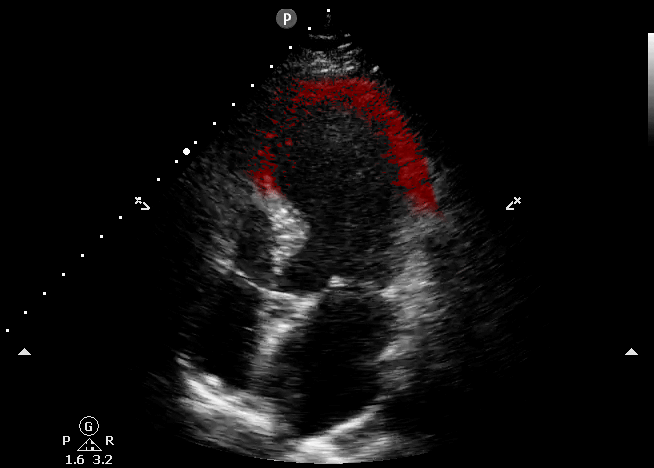This is a 50 year old female who presents with sudden onset retrosternal chest pain that began just after she heard of her sister’s death. Pain has been continuous for 2 hours, it is a dull ache. Vitals stable. Initial and 2 hour ECGs/troponins are shown, along with a bedside echocardiogram.


Answer: Takotsubo Cardiomyopathy (TC), aka Broken Heart Syndrome
This patient’s presentation of continuous chest pain, dynamic ECG changes (t-wave inversions laterally and ST segment elevation in the anterior leads), and increasing troponins is obviously concerning for acute coronary syndrome (ACS). The bedside echocardiogram performed showed no pericardial effusion and no signs of RV strain, but does show akinetic apical septum and LV apex in the vascular territory of the LAD. This can be described as “ballooning” of the LV apex. The basilar septal segment is spared. Overall left ventricular systolic function is moderately depressed. The IVC appears to have normal respiratory variation, suggesting a normal central venous pressure.

- This echo is a classic appearance for Takotsubo Cardiomyopathy, which typically comprises about 1-2% of all patients initially diagnosed with acute coronary syndrome (ST-elevation or positive troponins).1-3 90% of TC patients are female.4
- TC patients classically present with an acute emotional event followed by chest pain, although the inciting event can be physiologic rather than emotional stress (sepsis or stroke for example).
- The presentation can be identical to ACS: chest pain, ST elevation on ECG, elevated cardiac markers and regional wall motion abnormality (RWMA). Close to half of TC patients will have ST elevation on their ECG.4 It is not uncommon for the RWMA to cross multiple typical vascular territories on the echocardiogram.
- 80% of TC cases look like this on echocardiogram: apical ballooning. The second most common location is mid-ventricular, with remaining cases causing a more focal RWMA.4
- Most cases of TC present with elevated BNP and troponin levels, although interestingly they usually have normal creatinine kinase.4
- The disposition of suspected TC patients should be admission, as they have short-term morbidity and mortality similar to that of ACS, with a combined in hospital complication rate of 20%. Despite this, long term normal systolic function returns in most patients.4
- It should be noted that an acute stress response can also make a patient hypercoagulable5 and more hypertensive,6 potentiating a true ACS. There are no echocardiographic findings highly specific for TC. Ultimately, a cardiac catheterization is required to definitively differentiate true ACS from TC.
- This patient’s cardiac catheterization demonstrated completely normal coronary vessels, she had an uncomplicated hospital course.
- Kurowski V, Kaiser A, von Hof K et al. Apical and Midventricular Transient Left Ventricular Dysfunction Syndrome (Tako-Tsubo Cardiomyopathy) Frequency, Mechanisms, and Prognosis. Chest. 132(3):809-816. 2007. [article]
- Gianni M, Dentali F, Grandi AM, Sumner G, Hiralal R, Lonn E. Apical ballooning syndrome or takotsubo cardiomyopathy: a systematic review. European heart journal. 27(13):1523-9. 2006. [pubmed]
- Prasad A, Dangas G, Srinivasan M. Incidence and angiographic characteristics of patients with apical ballooning syndrome (takotsubo/stress cardiomyopathy) in the HORIZONS-AMI trial: an analysis from a multicenter, international study of ST-elevation myocardial infarction. Catheterization and cardiovascular interventions : official journal of the Society for Cardiac Angiography & Interventions. 83(3):343-8. 2014. [pubmed]
- Templin C, Ghadri JR, Diekmann J et al. Clinical Features and Outcomes of Takotsubo (Stress) Cardiomyopathy. N Engl J Med. 373(10):929-938. 2015. [PDF]
- von Känel R. Acute mental stress and hemostasis: When physiology becomes vascular harm. Thrombosis Research. 135:S52-S55. 2015. [PDF]
- Gasperin D, Netuveli G, Dias-da-Costa JS, Pattussi MP. Effect of psychological stress on blood pressure increase: a meta-analysis of cohort studies. Cadernos de saúde pública. 25(4):715-26. 2009. [pubmed]



